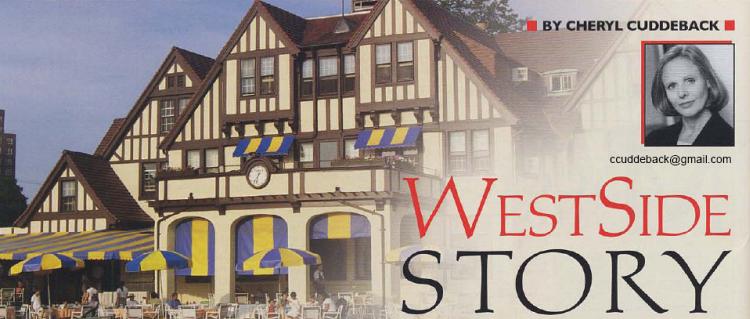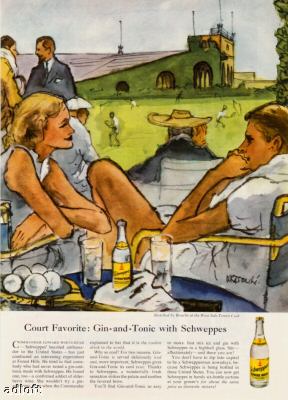
Home | Guestbook | What's New | Back

[Editor's Note: Thanks to Forest Hills Celebrity & Entertainment Magazine and to author, Cheryl Cuddeback, for permission to reprint the following article from the Magazine's August / September 2007 edition.]
For as long as I can remember Forest Hills has been synonymous with Tennis. Perhaps not to younger folks since the US Opens now take place in Flushing. But once upon a time The West Side Tennis Club hosted this grand event. Back then each summer our fair and self-contained gardens became the backdrop of movie and tennis celebrities alike. Camera crews and reporters could be found anywhere within the Station Square/Tennis Club radius poised with their booms and microphones ever ready to report the latest in scoops and scores. For one week we were it, the center of the stuff that made big news.
And to think this all started on account of a woman. After all, we wouldn't have the West Side Tennis Club if we didn't have tennis and we wouldn't have tennis if it wasn't for Mary Outerbridge.
She brought modern tennis to America in a bag. Coming home from a vacation in the Bahamas, her luggage included a parcel filled with tennis accoutrements. It didn't take long for this new fangled sport to take hold. Tennis clubs sprang up everywhere; the famed Casino Club in Newport Rhode Island and Boston's Brookline Country Club to name a few.
And then there was The West Side Tennis Club. It didn't have as glamorous a beginning as its counterparts. It all started with thirteen men renting an area at Central Park West and 88th St. On it were four clay courts and a shack used as the locker room. Due to its growth and rent increases the club moved two more times along Manhattan's west side before it ventured out to Queens. The club's directors envisioned a tennis haven for amateurs and pros alike. The new planned community of Forest Hills Gardens, built by The Russell Sage Foundation, was ideal. Not only would it provide a quaint country-like ambiance, its strict ordinances maintained the neighborhood's charming atmosphere. In 1914 The West Side Tennis Club officially set up shop in our town. Wooden grandstands, similar to those used at their previous Manhattan facility were erected to host 12,000 people attending the International Lawn Tennis Challenge, better known as the Davis Cup Matches.
On September 7, 1920 during one of the most dramatic matches of all time between Bill Tilden, the world's current tennis champion and William Johnson, who was the former national titleholder at the WSTC, an airplane crashed onto the court. The two military men in the plane died instantly. This was the third airline tragedy that had recently taken place in the U.S., all for the sake of getting a perfect picture of an historical sports event.
The oncoming years witnessed the emergence of women's tennis. In 1923 The United States Lawn and Tennis Association, USLTA, agreed to have the WSTC host the first ladies singles championship. Up until this time, women's games had been more for show instead of competitive play. France's Susanne Lenglen spear headed this new development. She not only wore a more revealing tennis outfit, instead of the traditional long sleeve and skirt tennis attire, her ballerina-like stance on the courts gave her the reputation of being a show off. But what made her different from her predecessors was her obvious determination to win, something spectators hadn�t witnessed before in women's tennis. Years later Helen Jacobs shocked spectators when she wear shorts onto the courts as did Gussie Moran when she wore white lace pants.
Once the West Side Tennis Stadium was built the world of tennis in Forest Hills steadily rose to a plateau. Crowds came to watch such greats as Pancho Gonz�lez, Rod Laver, and of course, Arthur Ashe, the first black to win the Men's Tennis Championship. But he wasn't the first black to play in the matches. Seventeen year old Althea Gibson made her debut in the U.S. Nationals at the WSTC in 1950. She played a stellar game up until an unusual heavy rainstorm that day. After lightening stuck one of the eagles that grace the stadium's parapet Gibson was only able to hold her own, which wasn't enough to win.
In 1955 the club voted to stay open year round. Paddle tennis and squash took on a life of there own. Even the club's bridge members became involved with The Interclub Contract League.
Tennis began to slightly wane during the late 50's. Looking for ways to supplement their losses, the WSTC rented out its stadium for concerts. Throughout July and August The Forest Hills Music Festival hosted concerts the likes that have never yet been repeated. Entertainers like Judy Garland, Frank Sinatra and Barbara Streisand graced us with their talent and presence. Before the Beatles played Shea Stadium they performed at the West Side. They arrived by a helicopter that landed on the Club's famed grass courts. John, Paul, Ringo and George were then whisked into the club's bridge room for a quiet dinner before facing their screaming fans. During the years that followed, other rock bands to appear included The Who, Ten Years After, Sly and the Family Stone, The Fifth Dimension, Dionne Warwick, Janis Joplin and lots more.. Even Jimi Hendrix as the leading act to The Monkees dazzled the audience with his guitar (He was definitely not booed off stage). Simon and Garfunkel's annual appearance always guaranteed a packed house since they were our local boys made good from Corona, Queens.
 1977 marked the end of an era for the WSTC.. It was the last year they hosted the National Tennis Matches. The new facilities in Flushing Meadow Park became the new America's Wimbledon. Yet even without the razamatazz of days past, the WSTC continued evolving. Women's' membership gained equal status as the men. In the earlier years female membership was limited both in numbers and voting rights. As recent as 30 years ago the men's locker room took up the entire 2nd floor of the club house while the women's locker room remained on the 1st floor taking up less than half the space as the men's area. Male members were able to sun in the nude on the 2nd floor outdoor porch and literally belly up to own bar, au naturale. Nowadays this same area is a lounge room of sorts with a large screen TV and couches. The porch is accessible to all. Membership is not only limited to the traditional white Anglo class. The unfortunate episode of the WSTC denying membership to the son of Ralph Bunch, the first black to win the Nobel Peace prize, is a thing of the past. Not to mention that these days, people from all religious beliefs can enjoy the benefits of membership, provided they can afford the dues. Children can now be seen and heard. During the club's weekly Sunday evening summer barbeques children of all ages have full rain of the grass courts as they run hither and yonder still in full view of their watchful parents; quite a far cry from olden days when families were allowed in the club only on special occasions. After all these years, an outdoor now pool graces the grounds. Sad to say, the nearby dressing rooms and eating area remain a work in progress even after seven years. But all these changes, as wonderful as they are, can only be experienced within the sequestered confines of the club's ivy fences.
1977 marked the end of an era for the WSTC.. It was the last year they hosted the National Tennis Matches. The new facilities in Flushing Meadow Park became the new America's Wimbledon. Yet even without the razamatazz of days past, the WSTC continued evolving. Women's' membership gained equal status as the men. In the earlier years female membership was limited both in numbers and voting rights. As recent as 30 years ago the men's locker room took up the entire 2nd floor of the club house while the women's locker room remained on the 1st floor taking up less than half the space as the men's area. Male members were able to sun in the nude on the 2nd floor outdoor porch and literally belly up to own bar, au naturale. Nowadays this same area is a lounge room of sorts with a large screen TV and couches. The porch is accessible to all. Membership is not only limited to the traditional white Anglo class. The unfortunate episode of the WSTC denying membership to the son of Ralph Bunch, the first black to win the Nobel Peace prize, is a thing of the past. Not to mention that these days, people from all religious beliefs can enjoy the benefits of membership, provided they can afford the dues. Children can now be seen and heard. During the club's weekly Sunday evening summer barbeques children of all ages have full rain of the grass courts as they run hither and yonder still in full view of their watchful parents; quite a far cry from olden days when families were allowed in the club only on special occasions. After all these years, an outdoor now pool graces the grounds. Sad to say, the nearby dressing rooms and eating area remain a work in progress even after seven years. But all these changes, as wonderful as they are, can only be experienced within the sequestered confines of the club's ivy fences.These days the stadium stands as a shell of yesteryear. There are no more crowds. No more music or paparazzi. Because we are no longer the 'it' neighborhood of the summer, our tennis club is the target for many a criticism for not hosting the large public events it once did. Oh there's talk of this championship or that concert taking place in the stadium but they're peanuts compared to the grandeur that once was. We can point fingers all we want but for now, the ball is in their court.
[Editor's Note: A lifetime resident of Forest Hills, Cheryl Cuddeback is a local historian and writer. She also runs her own PC training business in lower Manhattan.]
